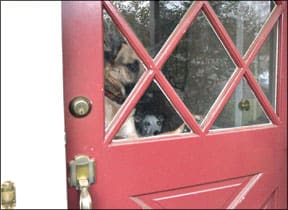[Updated December 14, 2018]
Unexpected visitors have pulled into your driveway, exited their car, and are walking up the steps to your front door. You brace yourself. You know what’s coming next. “Ding-Dong,” goes your cheerful doorbell, and your dog charges to the door, unleashing a frenzy of ferocious barking. Frustrated and angry, you yell at her to be quiet – to no avail – while you try to grab onto her collar and open the door to greet your guests. Her doorbell display is so embarrassing that you’re becoming more and more reclusive, meeting friends at restaurants rather than inviting anyone to your home for social events.

Don’t despair; you’re not alone. In fact, doorbell arousal behavior is pretty common. And there is hope.
Why Do Dogs Hate Doorbells?
Thousands of dog owners around the country have canine family members who present similar distressing doorbell behaviors. These dogs may be naturally somewhat protective, and quickly come to associate the ringing doorbell with the presence of an intruder on their property. Barking at the bell may send a serious “Go away or I’ll eat you” message. Even when there’s no aggressive intent, the excessive vocal display serves to announce an event they want the rest of the family to be aware of. “Someone’s here! Someone’s here!” If a doorbell-aroused dog is very social, his frenetic barking may also signify an excited, “Hurry, hurry, hurry and let ‘em in so I can jump all over them and say hi!”
From early puppyhood, dogs realize that the ringing of the doorbell itself is an event – it gets you excited. Really. What happens when the doorbell rings? One or more humans in the home jump up and move quickly to the door, usually with human body language arousal signals, including fast movement, alert or excited facial expression, tension in the muscles, and loud vocalization (“I’ll get it!” or “Be right there!”). It’s no wonder our dogs learn to get excited right alongside us as we dash to the door, “barking” our heads off.
It doesn’t even have to be the doorbell. Some dogs are equally aroused by a knock at the door, or the sound of footsteps up the walkway, or even a car pulling in the driveway. These are all things they’ve come to associate with the excitement of the event – someone coming to, and often coming in, the door.
Manage, Modify and Train Your Dog’s Doorbell Behavior
A good doorbell manners program is a combination of management, classical conditioning, and operant conditioning. Ideally, you implement the program before your dog learns inappropriate door behavior. If it’s too late for that, it’s never too late to start changing behavior.
If you start by programming appropriate classical and operant responses to door arrivals from day one, your dog will quickly learn incompatible operant behaviors in response to the environmental cues that someone is approaching his home. He will also make a different association with the arrival of guests, and as a result his emotional response will be relaxed and positive. If you’re having to undo previously programmed inappropriate behaviors, your training and modification program will take longer, but you can still accomplish your goal of calm instead of chaos when visitors arrive on your doorstep. Here are several options for achieving doorbell calm:
Mostly Classical
Classical conditioning means giving your dog an association between two stimuli. In the case of the doorbell or other “arrival” stimuli, you’re going to convince the part of your dog’s brain that controls emotion (the amygdala) that someone ringing the doorbell, knocking on the door, or walking up your front steps makes absolutely wonderful stuff happen. For our classical conditioning purposes, “wonderful stuff” likely means very high-value food, such as canned chicken (rinsed and drained), or some other moist, meaty, tasty treat that she doesn’t get in the normal course of events.
1. Have your dog on leash, preferably some distance from the door, and a large supply of very high-value treats.
2. Instruct another family member to ring the doorbell. Immediately feed your dog a high-value treat. Or ring the doorbell yourself and feed a treat, if a helper isn’t available. Look for a remote battery-powered doorbell at the hardware store or on the Web – one that sounds like your existing doorbell. Alternatively, you could record the doorbell ringing, and play the recording. Or download a recording of a ringing doorbell from the Internet and play that. (You can find doorbells, knocking, and just about any other sounds you can imagine online at findsounds.com/ISAPI/search.dll.) Practice at least twice a day, five minutes per session (more is better) until your dog looks happily to you for a treat when she hears the doorbell ring.
This is called a “conditioned emotional response” or CER. Note: If your dog already goes from zero to 100 the instant she hears the bell, you can reduce the intensity of stimulus to keep her below threshold by starting as far away from the chime box as possible, by reducing the volume of your chime box if you have that feature, or by using the recorded doorbell sound and turning the volume down low enough that she doesn’t go “over threshold” immediately upon hearing it. Part of your program will then also include gradually increasing the volume of the bell, before you move on to Step 4.

3. When you are getting consistent CERs from your dog at the sound of the doorbell, repeat the exercise with your dog off-leash, a short distance away from you. When she looks at you with her “Where’s my chicken?” CER and walks the few steps to you, feed her treats. You are adding operant pieces to her behavior now: she has the classical association between doorbell and chicken, but she’s choosing to come to you. That’s operant behavior.
4. When she’ll hustle to you from any point in the same room, build in a sit before you feed the chicken – more operant behavior. You may need to cue it at first, but your goal is to create an automatic sit, so that when the doorbell rings she runs to you and sits politely every time. You can encourage your dog to sit with your body language – stand up straight, and move your hand toward your chest if necessary – and eventually fade those cues by minimizing your movements, until she offers sits automatically.
5. Gradually increase the distance between you and your dog, until she comes running to you from any room in the house when she hears the doorbell, and offers a sit.
6. Now practice Steps 1 through 4 with real visitors coming to the house. You may have to bribe your friends with the promise of food; schedule a dinner party but ask your guests to arrive at 5- to 10-minute intervals so you get several practice sessions in a short time. If your friendships are strong you can even ask them to leave and come back a few times during the evening so you get more chances to practice.
When your dog is solid on the Step 5 behavior, you can slowly begin to diminish the frequency of your treat delivery. Make it random; don’t just suddenly stop treating, but skip one here and there, and use some other form of reinforcement that your dog loves, such as happy praise, a scratch in her itchy spot, or her favorite toy. Eventually you can phase out treats altogether, but be ready for remedial practice sessions if her door manners start to deteriorate.
Utilize the same process for door knocks, for people coming up the walk to your door, and for cars pulling in the driveway. Associate the stimulus with good stuff in order to give your dog a different behavioral response to the various sounds of visitors arriving.
Mostly Operant
Alternatively, you can choose a training approach that focuses on operant behavior from the start, by simply teaching your dog that the doorbell (or knock) is her cue to do a specific behavior, such as lie down on a dog bed you’ve strategically placed in your foyer, or run to her crate in the living room.
For best results, use backchaining for this exercise, meaning you’ll teach the last piece of the behavior first, and build backward until you’ve completed the entire behavior chain. If you’re going to teach your dog to lie down on a dog bed in your foyer, it would look like this:
1. Stand a foot from the bed and either lure or shape your dog to lie on the bed. To lure, say “Go to bed!” or “Doorbell!” or whatever cue you want to use, put a tasty treat in front of her nose and lure her onto the bed, then cue her to lie down. Click and give her a treat.
To shape the behavior, wait for any micro-movement toward the bed: even just a glance or a lean toward it. Then click and toss a treat behind your dog so she has to get up to eat it. When she comes back toward you (and the bed) take advantage of the “reset” to click while she’s moving, and toss the treat to reset her again – giving her another opportunity to move toward you (and the bed) and get clicked. When you have shaped her to go to the bed and lie down on it, then add your cue. (See “The Shape of Things to Come,” March 2006.)
2. When your dog will lie down on her bed on cue when you are a foot away, move another foot away from the bed and repeat the exercise (this part should go quickly).
3. Gradually move farther and farther away from the bed, making sure she does the “go to bed” behavior reliably at each new location before increasing distance. Practice from all different directions, until she will go to her bed on cue from anywhere in the foyer.
4. Now add the doorbell as a new “go to bed” cue. Whenever you add a new cue, you put it in front of the known cue, so you will ring the doorbell, then say “Go to bed,” and click and treat when she complies. You are saying to her, “Dog, this ‘ding-dong’ sound means the same thing as your ‘go to bed’ cue.”
5. With repetitions, you will see her start to move to her bed when she hears the doorbell, even before you give the verbal cue. This means she’s made the connection between the new doorbell cue and the old verbal cue. Click and jackpot with several treats one after the other when she lies down on her bed. You may need to remind her with the verbal cue few more times, but she’s there.
6. Now increase distance until she’ll go to her bed upon hearing the doorbell cue from anywhere in the foyer, and then generalize to anywhere in the house. Now when your dog hears the doorbell she’ll automatically run to her bed from anywhere in the house, and lie down.
If you prefer the crate in the living room scenario, just substitute “crate” for “dog bed” and follow the same steps. Note that while you were focusing on operant behavior in this training approach, your dog was also getting a positive classical association with the doorbell, because she was getting treats in close proximity to the sound of the chimes. Classical and operant conditioning are always both in play, even when we’re focusing on one or the other.

Management
As you work to create associations, modify behavior, and train new operant responses to the doorbell and other “visitors arriving” cues, you’ll want to include the always useful management piece of your behavior program.
When your dog has successfully arrived on her bed – either in response to your “in-progress” verbal cue, or to the doorbell itself – you can tether her there to prevent an after-the-fact aroused rush to greet your guests. To reinforce polite greeting as well as appropriate doorbell manners, offer your visitors treats and ask them to walk over to your dog and feed her treats as long as she is sitting or lying down. Tell them that if she stands up, jumps up, or barks, they should step back, wait for her to sit again, then feed her the treat and give her a scratch under the chin. (See “Greetings and Salutations,” April 2005.)
Note: If your dog barks aggressively at guests as they approach her on her tether, you’ll need a separate behavior modification program for the aggression. Please consult with a qualified positive behavior professional for assistance with this behavior challenge. Meanwhile, teaching your dog to run to her crate may be a better option for her than running to her bed in the foyer.
If you’ve chosen the crate instead of the dog bed, management is as simple as closing the crate door. When your guests have been greeted and made comfortable, barring aggressive behavior you can let your dog out, on-leash if necessary, for introductions. Depending on the degree of your dog’s doorbell arousal, baby gates and closed doors, or even a leash, can also effectively dampen or divert intense guest-arrival behavior.
Other Options for Changing Doorbell Responses
There are many other creative options for programming or modifying doorbell behavior. Here are two.
• Try changing your doorbell sound. If your dog has a very strong emotional response to the existing doorbell, it will be easier to give him a new association with a new sound. Don’t actually use it as your new doorbell until you’ve conditioned a very positive response for your dog (or trained him to perform an appropriate operant behavior in response to the new chime). When your training is completed, then substitute the new doorbell in place of the current one.
• Get a toy: You can teach your dog that the doorbell is her cue to run to fetch a toy. You can toss the toy for her to fetch (have her offer a sit first!), and thus focus her energies on the toy instead of the doorbell or your guests. You can also teach her to take the toy to your visitors, and construct a polite greeting behavior that includes sitting until they toss the toy for her.
• Manners Minder: This unique remote treat-delivery gadget was developed by veterinary behaviorist Sophia Yin for a variety of training and behavior applications, including door manners! The concept is simple. When you push a button, the unit beeps and delivers a treat. Your dog makes the classical association between the “beep” and treat, and quickly learns (operantly) to run to the machine when she hears the beep. The beep becomes the cue to run to the machine.
Then add the doorbell as the new cue to run to the machine, as in Step 4 of the “mostly operant” approach, above. Ring the doorbell, beep the beep, and the machine delivers. When the doorbell alone sends your dog to the machine, fade the beep cue by utilizing the “mute” feature of the remote: you press the button to deliver a treat but no beep occurs; the doorbell alone sends your dog to the machine for her treat. Gradually increase your dog’s distance from the machine so the doorbell sends her running to her Manners Minder from anywhere in the house.
It Takes Work, But It Works!
So there you have it: lots of ways to install appropriate doorbell manners in your dog. They work. One of my early clients had an Australian Shepherd with inappropriate doorbell behavior; she would run to the door barking fiercely when the doorbell rang. In a matter of just three weeks, Sasha learned to run to her bed and lie down calmly at the sound of the doorbell. Her owner was amazed and delighted. So was I.
DOORBELL BARKERS: OVERVIEW
1. Determine which approach to teaching good doorbell manners appeals to you and is most appropriate for your dog.
2. Make sure all family members are on board with the program; enlist friends, too, to help with implementation.
3. Remember to have fun with training. You and your dog will be most successful if you enjoy yourselves while you’re training!






Good article thank you..
I took my puppy from a dog foster home about a year ago. I love him to bits; he has a great personality, and I feel that he loves our family so much, but he barks A LOT… So, leaving home is always a challenge for us. My husband and I were thinking about taking him to ‘doggy school’, but then again, it’s extremely expensive, and the nearest ‘doggy school’ is far away from us. Maybe you have some advice? THANK YOU!!!